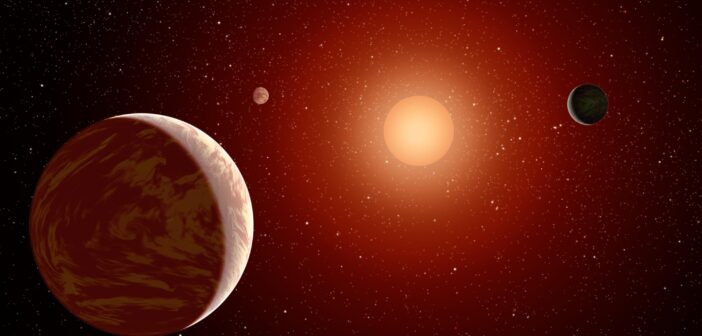Editor’s Note: Astrobites is a graduate-student-run organization that digests astrophysical literature for undergraduate students. As part of the partnership between the AAS and astrobites, we occasionally repost astrobites content here at AAS Nova. We hope you enjoy this post from astrobites; the original can be viewed at astrobites.org.
Title: A Comparison of the Composition of Planets in Single-planet and Multiplanet Systems Orbiting M dwarfs
Authors: Romy Rodríguez Martínez et al.
First Author’s Institution: The Ohio State University
Status: Published in AJ
The most common type of star in the universe is the M dwarf, making up ~70% of all stars. Because M dwarfs are so common, and because we know exoplanets are common, it is only natural that we have found many exoplanets orbiting M-dwarf stars. In fact, Astrobites covered seminal articles on the occurrence rate of planets around M dwarfs and their compositions; read them here and here. But with all these planets, we can take our knowledge one step further and begin to ask deeper questions. For example, in M-dwarf planetary systems, how do single-planet systems (only child) and multi-planet systems (siblings) compare?
A new study seeks to answer this question, focusing on three key parameters: planet bulk density, planet core mass fraction, and host-star metallicity. In particular, the authors wish to investigate whether siblings and only-child systems are two outcomes of the same formation process, or if they truly form differently. In other words, are they from the same population, or are they two distinct populations of planets?
Bulk Density
First, bulk density, or the average density of the planet as a whole. We know that Earth is made up of many different materials (rocks, water, gases, etc.) and each one of these has its own density. But for exoplanets, we cannot explore the details of different materials and so instead we measure bulk density by simply taking the total mass of the planet and dividing by the total volume (assuming the planet is a sphere). The authors compute bulk density for a sample of planets around M dwarfs, computing this quantity for both the single-planet systems and all the planets in multi-planet systems.
Next they apply a statistical test (the Kolmogorov–Smirnov test) to determine if the two sets of planets are truly distinct populations or are consistent with one population (see Figure 1 top panel). The result overwhelmingly shows that these are two different populations. However, the authors caution that this result may be biased. Many of the single-planet systems in the sample are giant planets, which are naturally lower density than smaller planets are because they have higher gas fractions. Removing the gas giants from the sample and re-running the test, the authors find that actually the siblings and only-child planets are consistent with coming from the same population (see Figure 1 bottom panel).

Figure 1: Top: The results of the statistical test when including all planets to determine if the two populations are distinct. The gap between the single and multis suggests they are indeed two populations. Bottom: The same as the top panel but for the sample that excludes giant planets. Here the finding of two populations is less statistically significant. [Adapted from Martínez et al. 2023]
Core Mass
Next, planet core mass. The mass of a planet is generally meant to include everything that makes up the planet. However, the core mass is just that, the mass of the core of the planet alone. Core masses are valuable pieces of information because it is thought that the size of the core, which is the first to form, can determine how big the planet eventually grows to be. Bigger cores are better at gravitationally attracting material, including gas, to grow the planet. While we cannot directly measure the core mass of a planet, we can use models that are tuned to Earth’s parameters to estimate planet core mass based on a few things we can measure, like mass and radius. Now taking only the planets that are likely to be rocky and again splitting by single versus multi-planet systems, the authors find that planets in single-planet systems have, on average, larger core masses than those in multi-planet systems. They further test if core mass correlates with orbital period but find no correlation.
Metallicity
Lastly, the authors explore the host star, particularly its metallicity, or the percentage of the star’s composition that is made up of “metals” (astronomers define “metal” as anything heavier than helium!). Host star metallicity is thought to correlate with the kinds of planets and number of planets in the system, the thinking being that since planets form out of the same disk of material as the host star, if there are more heavy materials in that disk (which would appear as higher metallicity in the host star) then there is more opportunity to make more and bigger planets. The authors here find that host stars of single planets are more metal rich than those hosts of multi-planet systems. This is counterintuitive, but the authors hypothesize this could be because more metal-rich stars might produce more and bigger planets, which may gravitationally interact in the early days of the system and fling out all but one planet. On the other hand, metal-poor stars cannot build big planets and instead build small planets that are dynamically “quiet.”
In all, the authors find that single- and multi-planet M-dwarf systems are likely two distinct populations. This could have large implications for how we understand the formation and evolution of planetary systems.
Original astrobite edited by Mark Popinchalk.
About the author, Jack Lubin:
Jack received his PhD in astrophysics from UC Irvine and is now a postdoc at UCLA. His research focuses on exoplanet detection and characterization, primarily using the radial-velocity method. He enjoys communicating science and encourages everyone to be an observer of the world around them.

